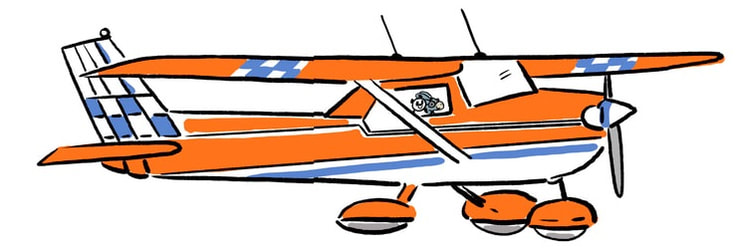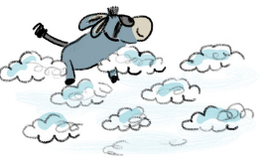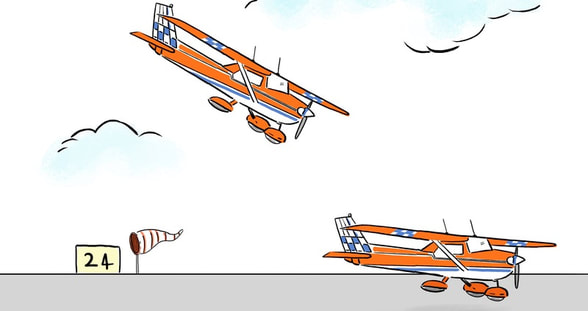|
There's a coyote on the runway! Lizzy & Stella had an interesting flight on July 22nd. The pair attempted to depart CYSN, but their plans were put on hold when Kyle the Coyote decided to appear on Runway 6 at CYSN. What do you do when there's a coyote on the runway? You do a few things: 1. Radio the Tower or Flight Service Station (FSS) to let them know there's a coyote out and about on the runway 2. Let the coyote pass 3. Radio your intentions and take off when it's safe to do so In some cases, wildlife on the runway may result in a Civil Aviation Daily Occurrence Reporting System (CADORS) filing. These reports help to notify pilots and the public about flight-related incidences and potential safety concerns. In Lizzy & Stella's case, there was only a slight delay in their departure so Kyle never made it into the CADORS database. However, as you'll see in this lesson, other coyotes have. As you'd expect, wildlife encounters in Canada aren't that uncommon. Curious to find out more? You can head here to learn more about CADORS or to query some of the reported occurrences. Just one last question now that Lizzy, Stella and Kyle are all safe. Are you ready to fly? Stella & Lizzy are back up in the air as of July 6, 2023. We couldn't be more excited! Their first flight together this year took them to Tillsonburg to deliver copies of Stella's Stories from around the Globe: Stella & Lizzy take Flight. Interested in buying your own copy? If so, head here for various retailers. Remember to please try and support local. Back to their flight. Tillsonburg is a town of about 20,000 people and it's around 120-minutes (2-hours) by car from Niagara-on-the-Lake. It's a lot faster by plane though, so Stella & Lizzy opted to fly and made the return trip in a little over 100-minutes. That's there and back! They flew from CYSN (St. Catharines Niagara District Airport) and landed at CYTB (Tillsonburg Airport). They then quickly dropped by the books and departed CYTB for CYSN. Are you interested in flying? If so, then you should definitely check out COPA. It's a program aimed at getting young people interested in flight. The flights depart from Welland, Ontario. You get the chance to head up in the air with a pilot for about 20-minutes of flying fun. You can go to their site to find out more. This year's flight is on August 19th, so you better hurry up and register if you are interested in taking part. Let's follow Stella & Lizzy as they head to Tillsonburg & back. Are you ready for another adventure? Here are some lessons to keep you learning while this dynamic duo takes a pause. They'll be back up in the air together next August or September. Until then....... keep your head in the clouds. Last Saturday was Lizzy & Stella's final flight for 2022. This dynamic duo are parting ways. Don't worry though, they'll be back up in the air next August and that's when our regular lesson postings will recommence. In the meantime...... I'll get to creating and posting some downloadable activities. Stay tuned and remember to keep your head in the clouds. Last Saturday, Lizzy taught Stella all about landing planes. Do you want to learn more about landings? You can view the lesson here: Stella and I aren't quite sure what the world record is for the most hammerheads performed during a single flight, but we're pretty certain that she might one day break that record. Stella loves this manoeuvre. Lizzy and Stella did a total of ten hammerhead stunts today. Ten! Before Lizzy had finished the first, Stella was asking her to perform the next one. As you can probably tell, this is Stella's favourite stunt. Check out this daring duo as they perform snap rolls and hammerheads: Does this look like fun? In the previous lesson, Stella & Lizzy performed something called a Cuban 8. Lizzy calls it an Eliza 8, and this is what the move looks like. You get both an interior (inside the plane) and exterior (outside of the plane) view. We've seen Lizzy and Stella perform some stunts in the past, but now you'll get to learn more about a few of them: ✈️ Aileron roll ✈️ Loop ✈️ Eliza 8 The Eliza 8 is a slightly modified Cuban 8. G Forces play a big part in aerobatics since Lizzy's quickly ascending, descending, inverting the plane and performing sharp turns. Since Stella's a bit less experienced with aerobatics, you'll definitely see her reactions in the videos. Sometimes she leans, sometimes she seems to be pushed down in her seat, and sometimes she seems like she's having the time of her life. You've probably experienced similar reactions while on a roller coaster. Watch as Lizzy and Stella perform some awesome aerobatics. Are you ready for some spectacular stunts? Lizzy recently appeared in the news. Check out her story here. Just a side note, we call the plane Vyctor. With flying, Lizzy can get herself caught up in some pretty cool stunts. This is because Vyctor is an aerobatic plane designed to do rolls, loops, inversions, and all sorts of fun stuff. Watch as Lizzy, Stella and Vyctor perform aerobatics. Try to observe any changes you see in terms of their position in the plane, the position of the plane itself, or how objects move about the cockpit. Ready. Set. Let's learn about aerobatics! Some of the embedded videos get cut short, so you can view the full videos here.
We have some news. We were in the news! Here's a link to a recent article written by Abby Green of Metroland Media Inc. Here's the article. Lizzy and Stella had several goals with this last lesson. Goal #1: Learn the basics of take-off and review how turf (ground cover) affects take-off. Goal #2: Review reading and setting the altimeter. Remember, the altimeter measures Vyctor's height about mean sea level (MSL) and it's affected by air temperature and pressure. Goal #3: Stay safe by inspecting Vyctor prior to flight. Goal #4: Apply what was covered and fly from Niagara District Airport (CYSN) to Welland's Dorothy Rungeling Airport (CNQ3) to practice arriving (landing) and departing (take-off). Lizzy and Stella took off from a grassy runway. Are you ready to fly? Do you remember from earlier lessons what the altimeter is and what it measures? The altimeter is one of many instruments on Vyctor's instrument panel. The altimeter measures the plane's altitude above mean sea level (MSL) and it's set by Lizzy using the current barometric pressure. Barometric pressure changes with air temperature, so Lizzy often needs to adjust her altimeter reading during flight since she's ascending (going up) and descending (going down). As a plane climbs (ascends), air pressure typically drops because the air gets colder the higher up you go. Let's start with a quick review of weather, common conversions, and airport configurations. We'll also analyze altimeters in a bit more detail. Are you ready to learn about altimeters alongside Lizzy and Stella? |
Dynamic DuoLizzy and Stella love to fly! Join this dynamic duo as they soar through the clouds on another adventure. Archives
July 2024
Categories
All
|







 RSS Feed
RSS Feed